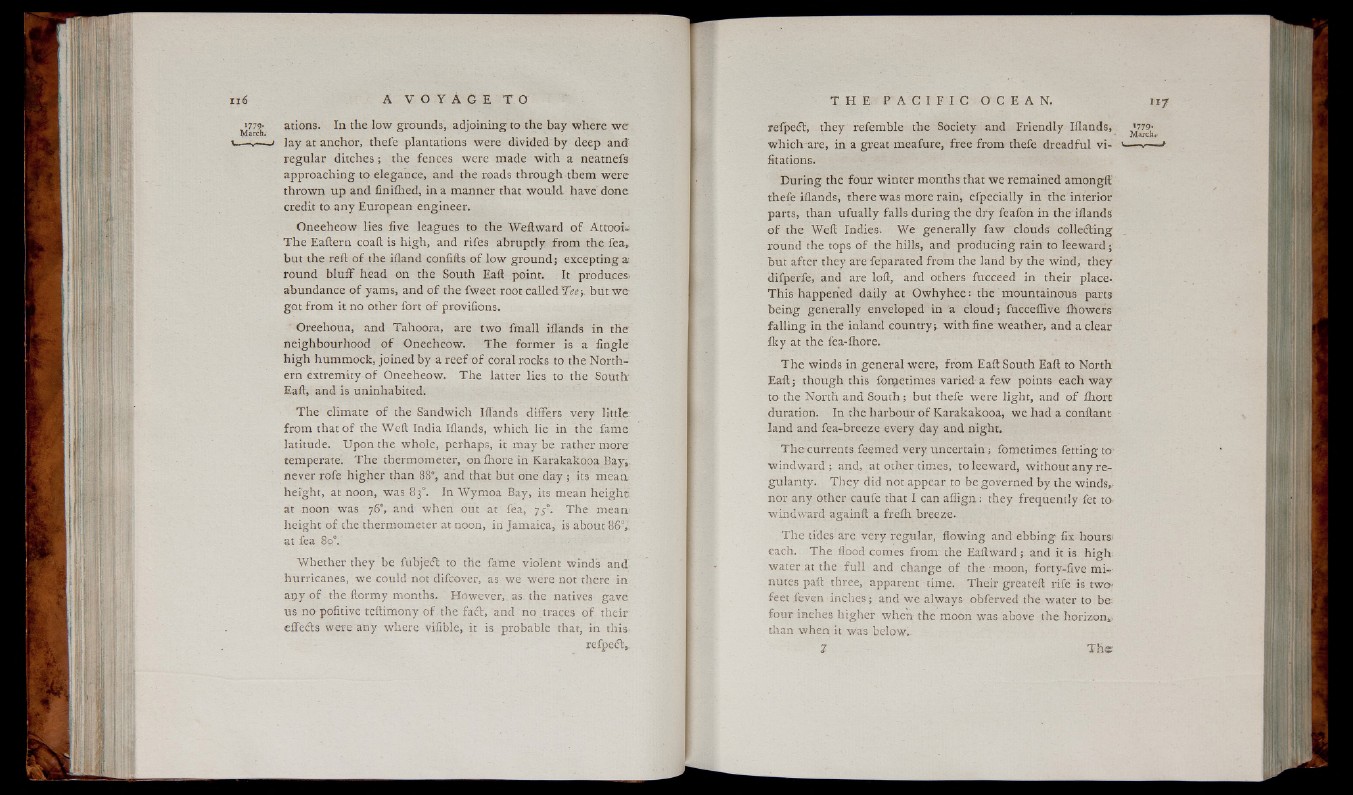
ations. In the low grounds, adjoining to the bay where w e
la y at anchor, thefe plantations were divided by deep and
re gu la r d itch e s ; the fences were made w ith a neatnefs
approaching to elegance, and the roads throu gh them w ere
thrown up and finiihed, in a manner that w o u ld have done
credit to. any European engineer.
Oneeheow lies five leagues to the Weftward o f Attooi-
T h e Eaftern coaft is high, and rifes abruptly from the fea,,
but the reft o f the ifland confifts o f low ground; excepting at
round b lu ff head on the South Eaft point. It produces,
abundance o f yams, and o f the fweet root called Tee-,, but w e
g o t from it no other fort o f provifions.
Oreehoua, and Tahoora, are two fmall ¡Hands in the
neighbourhood o f Oneeheow. T h e former is a fing le
h ig h hummock:, joined by a re e f o f coral rocks to the Northern
extremity o f Oneeheow. T h e latter lies to the South
Eaft, and is uninhabited.
T h e climate o f the Sandwich IlTands differs ve ry little
from that o f the Weft India Iflands, w hich lie in the fame
latitude. Upon the whole, perhaps, it may be rather more
temperate. T h e thermometer, on fhore in Karakakooa Bay,
never rofe h igh e r than 88°; and that but one day ; its mean
he ight, at- noon, was 83°. In Wymoa Bay, its mean h e ig h t
at noon was 76°, and when out at fea, 75'. The mean
h e igh t o f the thermometer at noon, in Jamaica, is about 86°,:,
at fea 8o°.
Whether they be fubjedt to the fame violent wind's and
hurricanes, w e could not difcover, as w e were not there in
any o f the ftormy months. However, as. the natives gave
us no pofitive teftimony o f . the fa f f , and no traces o f their
effedls were any where vifible, it is probable that, in this
refpedl, the y refemble the Society and Friendly Illands,
w h ich ate, in a great meafure, free from thefe dreadful vi-
fitations.
Du rin g the fo u r winter months that w e remained amongft
thefe illands, there was more rain, efpecially in the interior
parts, than u fu a lly falls d uring the dry feafon in the illands
o f the Weft Indies. We gen e ra lly faw clouds collecting
round the tops o f the hills, and producing rain to le ew a rd ;
but after they are feparated from the land by the wind, th e y
difperfe, and are loft, and others fucceed in their place.
This happened daily at O w h yh e e : the | mountainous parts
be in g gen era lly enveloped in a cloud ; fuccellive Ihowers
fa llin g in the inland country; w ith fine weather, and a clear
ik y at the fea-lhore.
T h e winds in general were, from Eaft South Eaft to North
Eaft; though this foipetimes varied-a few points each w a y
to the North and S o u th ; but thefe were ligh t, and o f ihort
duration. In the harbour o f Karakakooa, we had a conftant
land and fea-breeze every day and night.
T h e cu r ren ts feemed ve ry u n c e r ta in ; fometimes fetting to
windward ; and, at other times, to leeward, without any regu
larity. T h e y did not appear to be governed by the winds,,
nor any other caufe that I can a ff ig n : they frequently fet to
windward againft a fre lh breeze.
T h e tides are ve ry regu lar, flowin g and ebb in g fix hour si
each. T h e flood comes from the Eaftward ; and it is high:
water at the fu ll and change o f the moon, forty-five minutes
paft three, apparent time. T he ir greateft rife is tw o
feet feven in ch e s ; and we always obferved the water to be:
four inches higher w h en the moon was above the horizon,,
than when it was below.
7 Th«s
1779.
Marche